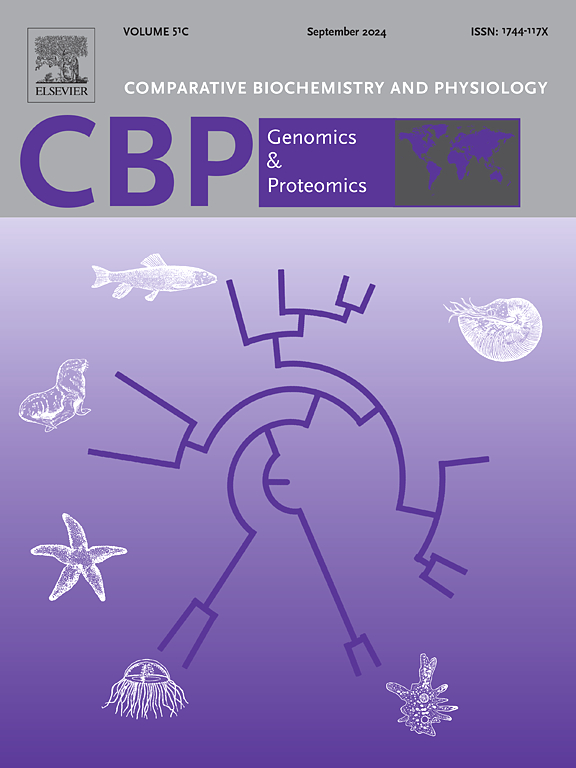Multi-omics analysis of Pacific oyster “Haida No. 1” strain and wild population reveals growth-related genes and transcription regulatory network
IF 2.2
2区 生物学
Q4 BIOCHEMISTRY & MOLECULAR BIOLOGY
Comparative Biochemistry and Physiology D-Genomics & Proteomics
Pub Date : 2025-05-28
DOI:10.1016/j.cbd.2025.101549
引用次数: 0
Abstract
Selective breeding has significantly enhanced the growth properties of Pacific oysters (Crassostrea gigas), but the molecular mechanisms behind these improvements remain largely unclear. In this study, we performed a comparative analysis of the adductor muscle transcriptome and proteome of the 10th-generation Pacific oyster strain “Haida No.1” and wild populations. Combining multi-omics analysis with published whole-genome resequencing and LC-MS metabolomics data of the “Haida No.1” strain and wild populations, we identified growth-related genes and transcription regulatory networks in C. gigas. Transcriptome analysis revealed 4110 differentially expressed genes (DEGs), significantly enriched in 49 pathways. Proteome analysis showed 105 differentially expressed proteins (DEPs) between “Haida No.1” and wild populations, which were enriched in 30 relevant pathways, including metabolic pathways, oxidative phosphorylation, ribosomes, phagosomes, and amino acid biosynthesis. Multi-omics analysis grouped these DEGs, DEPs, and selected genes (from Fst and XP_CLR analyses of previous whole-genome resequencing results) into 13 categories. The shared pathways were classified into five main classes: signal transduction, metabolism & biosynthesis, disease, cellular processes, and cellular components. Multi-generation selection has influenced the cellular behaviors and physiological processes of “Haida No.1”, which might explain its faster growth compared to wild populations. These findings provide novel insights into oyster growth regulation and offer candidate genes for oyster breeding programs.

对太平洋牡蛎“海达1号”品系和野生种群的多组学分析揭示了生长相关基因和转录调控网络
选择性育种显著提高了太平洋牡蛎(长牡蛎)的生长特性,但这些改进背后的分子机制仍不清楚。本研究对第10代太平洋牡蛎品系“海达1号”与野生种群的内收肌转录组和蛋白质组进行了比较分析。结合多组学分析和已发表的“海达1号”菌株和野生种群的全基因组重测序和LC-MS代谢组学数据,我们确定了C. gigas生长相关基因和转录调控网络。转录组分析显示4110个差异表达基因(DEGs),在49条通路中显著富集。蛋白质组学分析显示,“海大1号”与野生群体存在105个差异表达蛋白(DEPs),这些差异表达蛋白富集于30条相关途径,包括代谢途径、氧化磷酸化途径、核糖体途径、吞噬体途径和氨基酸生物合成途径。多组学分析将这些deg、dep和选定的基因(来自先前全基因组重测序结果的Fst和XP_CLR分析)分为13类。共有的通路可分为五大类:信号转导、代谢和amp;生物合成、疾病、细胞过程和细胞成分。多代选择影响了“海大1号”的细胞行为和生理过程,这可能是其生长速度快于野生群体的原因。这些发现为牡蛎生长调控提供了新的见解,并为牡蛎育种计划提供了候选基因。
本文章由计算机程序翻译,如有差异,请以英文原文为准。
求助全文
约1分钟内获得全文
求助全文
来源期刊
CiteScore
5.10
自引率
3.30%
发文量
69
审稿时长
33 days
期刊介绍:
Comparative Biochemistry & Physiology (CBP) publishes papers in comparative, environmental and evolutionary physiology.
Part D: Genomics and Proteomics (CBPD), focuses on “omics” approaches to physiology, including comparative and functional genomics, metagenomics, transcriptomics, proteomics, metabolomics, and lipidomics. Most studies employ “omics” and/or system biology to test specific hypotheses about molecular and biochemical mechanisms underlying physiological responses to the environment. We encourage papers that address fundamental questions in comparative physiology and biochemistry rather than studies with a focus that is purely technical, methodological or descriptive in nature.

 求助内容:
求助内容: 应助结果提醒方式:
应助结果提醒方式:


